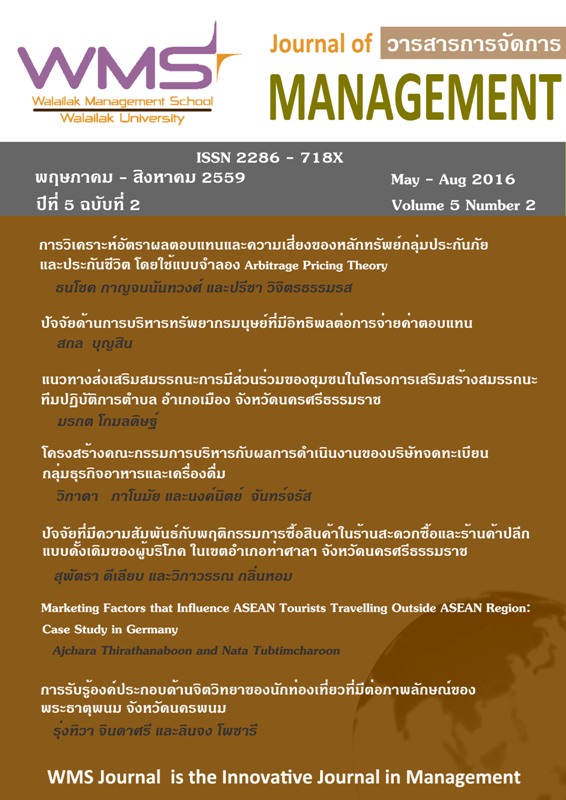Marketing Factors that Influence ASEAN Tourists Travelling Outside ASEAN Region: Case Study in Germany
Main Article Content
Abstract
The purposes of this research are to study satisfaction level of ASEAN tourists who travel outside ASEAN countries and examine influencing factors that impact their decision to travel outside Southeast Asia. Quantitative and qualitative approach being used regarding research methodologies, the 7Ps of marketing mix and the Voice of Customers (VOC) with questionnaires and in-depth interview from ASEAN travelers who traveled in Munich, Germany from October to December 2014.
The greatest influencing factors and level of satisfaction is a component of physical evidence such as safety, security and sanitation which is the outstanding element that ensures the quality of tourism product and motivates travels outside Southeast Asia region. Recommendations for implications, accomplice should consider establishing marketing plan and strategies in order to promote tourism in provincial area or local region base on physical evidence as mentioned to increase customers’ satisfaction effectively.
For further research, it is an opportunity to conduct market research for product positioning, perceptual map and marketing strategies according to response customers’ expectations more effectively. In other perspectives, researchers can study more in-depth and be more specific such as how to increase tourists’ level of satisfaction in ASEAN countries, how to motivate intra-visitors to revisit in Southeast Asia.Article Details
References
ASEAN Secretariat. (2008). The ASEEAN Charter. Jakarta, Indonesia
ASEAN Secretariat. (2012). ASEAN Tourism Marketing Strategy (ATMS) 2012-2015. Jakarta, Indonesia.
ASEAN Secretariat. (2014, January 31). Tourism Statistics. Retrieved October 10, 2014, fromhttp://www.asean.org/ news/item/tourism-statistics
ASEAN Secretariat. (2014, December). Selected Key Indicators. Retrieved September 7, 2014, from http://www. asean.org/news/item/selected-key-indicators
Asiegbu, I. F., Igwe, P., & Akekue-Alex, N. (2012). Physical Evidence and Marketing Performance of Commercial Airlines in Nigeria. American International Journal of Contemporary Research, 2(12).
Blanke, J., & Chiesa, T. (2013). The travel & tourism competitiveness report 2013: Reducing barriers to economic growth and job creation.
Booms, B., H., and Bitner, M., J., (1981). Marketing strategies and organization structures for service firms, in Donnelly, J., H., and George, W., R., (eds). Marketing of Services. Chicago: American Marketing Association.
Burns, A. C., & Bush, R. F. (2003). Marketing research: Online research applications (4th ed.). Upper Saddle River, NJ: Prentice Hall.
Chen, A. H., Peng, N., & Hackley, C. (2008). Evaluating Service Marketing in Airline Industry and its Influence on Student Passengers’ Purchasing Behaviour-using Taipei-London Route as an example. The Journal of Travel and Tourism Marketing, 25(1), 149-160.
Federal Ministry of Economics and Energy. (2014). Incoming-Tourism Germany Facts and Figure 2013. Frankfurt, Germany: German National Tourist Board (GNTB).
Furukawa, I., Jin, C., & Kamata, H. (2012). Evaluation of japan as a tourist destination - Case of East Asian people who have been to japan. International Journal of Hospitality and Tourism, 1(2), 80-95.
Gaskin, S. P., Griffin, A., Hauser, J. R., Katz, G. M., & Klein, R. L. (2011). Voice of the Customer. In Wiley international encyclopedia of marketing (Vol. 5). doi:10.1002/9781444316568. wiem05020
Griffin, A. & Hauser, J. R. (1993, Winter). The Voice of the Customer. Marketing Science, 12(1), 1-27.
Kasper, H., Helsdingen, P., & Gabbott, M. (2006). Services marketing management: A strategic perspective. Chichester, West Sussex: John Wiley & Sons.
Ken Black. (2014). Business Statistics for Contemporary Decision Making. (Fourth (Wiley Student Editioon for India) ed.). Wiley-India. ISBN 078-81-265-0809-9
McCarthy, E.J. (1964). Basic marketing. Homewood, IL: Irwin.
Muala, A. A., & Qurneh, M. A. (2012). Assessing the Relationship between Marketing Mix and Loyalty through Tourists Satisfaction in Jordan Curative Tourism. American Academic & Scholarly Research Journal, 4(2).
Munich Airport. (2015). Munich Airport - World Airport Awards 2014. Retrieved from http://www.munich-airport.de/en/ company/facts/preise/skytrax/skytrax_2014/index.jsp
Park, D., & Shin, K. (2012). The Service Sector in Asia: Is It an Engine of Growth?. (322) Philippines: Asian Development Bank.
Rafiq, M., & Ahmed, P. K. (1995). Using the 7Ps as a generic marketing mix : an exploratory survey of UK and European marketing academics. Marketing Intelligence & Planning, 13(9), 4-15.
doi:10.1108/02634509510097793
Salleh, M., Omar, K., & Yaakop, A. Y. (2013). Tourist Satisfaction in Malaysia. International Journal of Business and Social Science, 4(5), 221-226.
Sarker, M. A., Aimin, W., & Begum, S. (2012). Investigating the Impact of Marketing Mix Elements on Tourists' Satisfaction: An Empirical Study on East Lake. European Journal of Business and Management, 4(7), 273-283.
Sereetrakul, W. (2012). A Comparison of Satisfaction with Bangkok Tourism Marketing Strategies of Local and Foreign Tourists. European Journal of Social Sciences, 34(1), 99-105.
WTTC. (2014a). Travel & Tourism Economic Impact 2014, Southeast Asia. London, UK.
WTTC. (2014b). Travel & Tourism Economic Impact 2014, World. London, UK.
The Bavarian State Office. (2015). Landeshauptstadt München - Facts and Figures. Retrieved from http:// www.muenchen.de/rathaus/home_en/Touristoffice/Salesguide/Facts -and-Figures/Archiv_neu
The World Bank. (2015). International tourism, number of arrivals. Retrieved July 6, 2015 from http://data.worldbank.org/ indicator/ST.INT.ARVL/countries?display=default
Yamane, T. (1967). Statistics, An Introductory Analysis, 2nd Ed., New York: Harper and Row.

